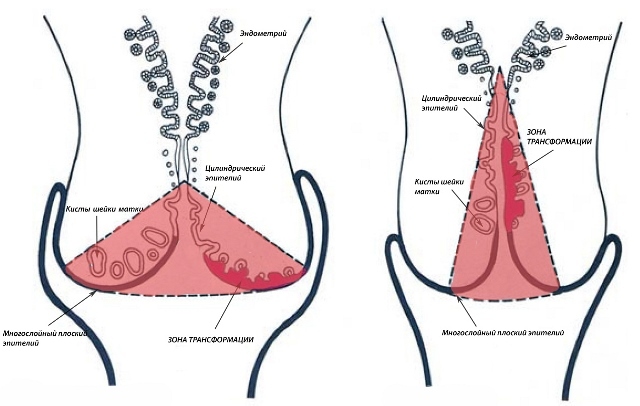Diseases of the cervix in modern ecology are quite common among the female population of most countries of the world. The consequences of treatment for a similar pathology, for example, monthly after conization of the cervix, are of great interest for practicing doctors and their patients.
For successful recovery after radical treatment it is important to imagine possible consequences of this intervention. The rehabilitation period largely depends on the choice of the gynecologist's methods of influencing the diseased organ.
Conosis of the cervix: consequences of
Most often after a wireThe woman is worried about the pain in the lower abdomen of the pulling character. Similar symptoms can last up to 2 - 3 weeks. Specialists recommend that their patients take anesthetic medication at this time.
With regard to the onset of the next monthly, the surgery performed does not affect their sequence. Menstrual bleeding usually comes in due time, however their intensity is more pronounced. Many women are compelled during this period to take iron preparations to compensate for blood loss.

These manifestations should not frighten patients, but in the presence of severe bleeding, consult a doctor. Abundant blood flow during the first months after the operation can usually be in 3% of women, but alertness in this case will not hurt.

Conization of the cervix
Brief description of the method of diathermoelectroconjuration
This method of treatment of the pathology of the female genital area is the second largest in terms of the total number of operations performed in this contingent of patients. In modern clinics, a special electrode is used for operative intervention in such an intimate and tender place. It is a cone generator of the European model, modified by the obstetrician-gynecologist Rogovenko S.
. The essence of the treatment technique is that with this electric knife, the damaged cervical tissue is cut with a cut in the formcone, with the acute side usually facing inside the uterine cavity. The resulting stump coagulates, in its place is formed a scab, which after a while disappears.
It is from the depth of tissue damage to the electrode and the rate of death of coagulated tissues that it depends when the first months after the conization of the cervix begin.
Diathermoelectroconjuration is widely used for differential diagnosis of pathology in the vaginal and cervical region. With the help of electrodes, a so-called conization biopsy is performed, which, thanks to the morphological pattern of the layered cut of the cervical tissue, allows the final diagnosis and the patient to be prescribed appropriate therapy.
It is not necessary to go into all the technical subtleties of conducting DEE in patients, since such things are interesting, mainly, only to specialists. It should be noted that this operation is performed without anesthesia, in rare cases it is recommended that local administration of novocaine or bupivokaine.
Features of early postoperative period in similar patients
For 10 to 15 days after the conization, women usually complain to their doctor about the abundant bloody discharge from the vagina. A similar pattern can persist until the complete removal of the scab from the vaginal cavity.

The physician should warn the patient before performing the manipulation that the plentiful monthly after conization of the cervix should not frighten her. So the organism of the patient reacts to the surgical intervention. Over time, if there are no complications, the volume of allocated menstrual blood will gradually return to the usual preoperative rate.
Look at the video about the procedure:
Possible negative consequences of excision of the cervix
It should be noted that modern gynecology clearly distinguishes all the complications of this operation into three main groups at the time of their occurrence.
Early postoperative problems of
The time period for the development of female genital disorders related to congenital congestion is 3 to 5 months after surgery. Most often, various bleeding from the vagina is attributed to the intervention or as a result of early rejection of the scab.
This contingent of patients may develop inflammation in the uterus and appendages. Similar complications occur in 1 - 3% of operated women.
The openings with the menstrual cycle are most often simply provoked by the operation, but hyperpolymenorrhea and various acyclic bleeding specialists refer to the effects of excision of the cervix. If a woman's period after conization of the cervix began earlier, then most often this is a consequence of the transferred manipulation.
Late complications in patients who underwent diathermal electroconjection
If after the operation more than 6 months have passed, usually doctors talk about late complications of this medical procedure. This includes:
- Shortening of the length of the cervix, accompanied by the loss of the mucous cervical canal.
- In 5 - 7% of cases in patients after a similar operation, a sharp narrowing of the cervical canal develops. This pathology requires an operative increase in diameter by special dilators. This is necessary to normalize the discharge of blood from the uterus during menstruation.
- Possible inflammatory processes that occurred at the site of the operation. Isolate cervical endometriosis and pseudo-erosion of this site. A similar pathology is described in 12-18% of patients after conization.
There is also a large number of remote consequences of such manipulation, however this is the topic of a separate conversation. We only note that different variants of the ovarian-menstrual cycle disorder are possible in every 6 women who underwent DEE.
Features of menstruation after similar operations
In addition to various complications associated with the development of the inflammatory process in the field of surgery, many patients are concerned about possible violations of menstruation in the postoperative period. Most often, these problems occur in the first 2 - 3 months after the surgery.
When a woman has begun her period after conization of the cervix, she will certainly pay attention to their excessive abundance. This is due to the restructuring of the hormonal system and the local haemostatic reactions of its body.
After rejection of the scab for 2 to 3 months, the patient undergoes epithelization after excision of the cervix. The length of the recovery period determines the length of time for menstrual irregularities.
In a remote period, complications with menstruation may occur if the cervix decreases sharply in diameter as a result of postoperative spasm. Menstrual blood does not get enough output from the uterine cavity and can lead to the development of an inflammatory process. To prevent such complications, specialists resort to bougie cervical canal.
According to modern medical statistics, problems with monthly after such operations are registered in 20% of patients, while it is noted that these disorders, as a rule, are of a temporary nature.
Treatment of bleeding
If a patient develops early bleeding after conization, the actions of health workers depend on his strength and duration. Abundant bleeding requires additional hemostasis with DEC with minimal current intensity or various local haemostatic procedures.
Tampons with hydrogen peroxide, adrenaline or aminocaproic acid are helpful in such problems. 3% warm solution of hydrogen peroxide is recommended and in the form of baths, moxibustion of the bleeding surface with potassium permanganate is indicated.
If necessary, operative stop of bleeding is possible. In this case, the cervix of the uterus is stitched or coagulated by using a laser.
The plentiful, monthly, arising after carrying out of similar manipulation, in most cases do not demand specific treatment, as they are temporary and functional. If there is a threat of a critical fall in the indicators of red blood, conduct appropriate symptomatic therapy.

We recommend reading an article about cervical dysplasia. From it you will learn about the causes of the pathology and its diagnosis, the methods of treatment, the effectiveness of conservative and operative therapy, as well as the recovery of the body after treatment.
As mentioned above, menstrual cycle disorder after conization of the cervix is found in only 20% of patients. According to this indicator, diathermoelectroconjuration refers to the most sparing methods of treating pathological changes in the tissues and cells of this organ problem in most women. However, with prolonged menstruation, as well as other alarming symptoms, it is better to consult a doctor.
